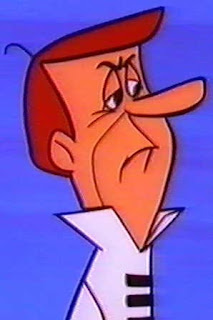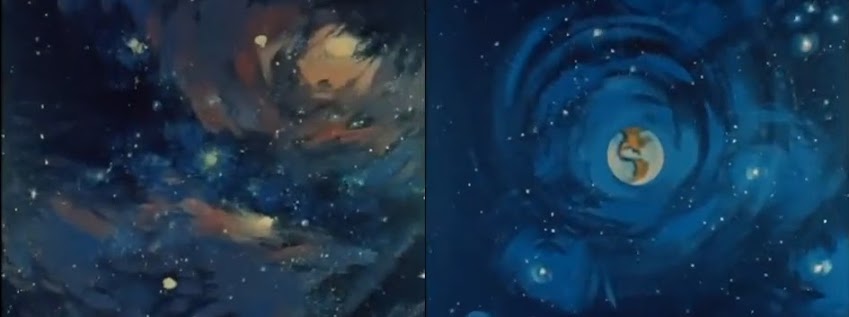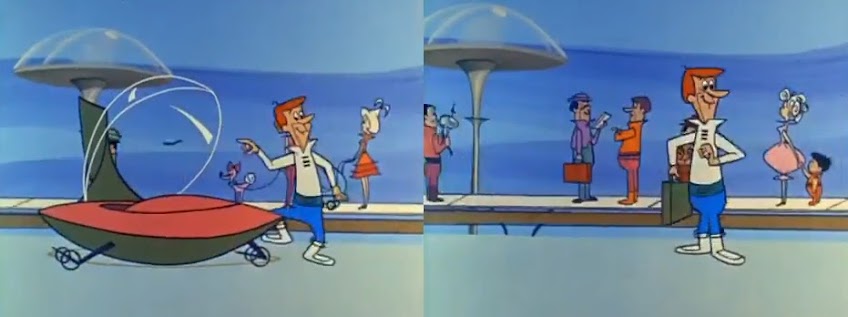 |
| The Jetsons: Happy sci-fi family or harbingers of doom? |
Instead, The Jetsons takes place right here on Earth -- specifically the United States of America, judging by the characters' accents and the money they use. The titular family resides in a fictional locale called "Orbit City." Most sources claim that the events of the series occur in the year 2062, an assertion backed up by a vintage ABC network promo in which the show's main character, George Jetson (voiced by George O'Hanlon), mentions that he and his family live in "the 21st Century." The year 2062 seems logical, as it would be 100 years after the show's original premiere date.
 |
| Why so sullen, George? |
Though cheerful on the surface, The Jetsons contains some bleak omens for our planet and its inhabitants. When a feature-length film adaptation of the series finally appeared in 1990, that long-submerged pessimism rose to the surface.
According to the environmentally-conscious script of Jetsons: The Movie, the surface of the earth has become uninhabitable due to pollution. This development should come as no surprise to long-time Jetsons viewers. The clues are all there in the original 1960s series, which debuted only a month before the Cuban Missile Crisis.
The good news is, you don't have to watch beyond the first 60 seconds of any given episode of The Jetsons to find this. It's all right there in the opening credits. Let's examine this famous introduction carefully and consider its implications as we go. The renowned and innovative theme song by Hanna Barbera's in-house composer, Hoyt Curtain, is lyrically neutral to an almost suspicious extent. It is merely a roll call of the series' main characters.
Meet George Jetson!The Jetsons was conceived, produced, and marketed as a counterpoint and companion series to The Flintsones, but that show's theme promised its viewers "a gay old time." The Jetsons makes no such promises. All its theme song tells us is the names of four of its characters and their relationship to one another, with the father and lone breadwinner singled out as the hub or nexus of the family unit. That's it.
His boy Elroy!
Daughter Judy!
Jane his wife!
Visually, the title sequence begins by showing the vast, mysterious cosmos, but within seconds, our view settles on a familiar sight: Earth.
 |
| The vast cosmos; Earth comes into view. |
We move in even closer to Earth and see a rather distorted view of North and South America. The Gulf of Mexico and the Hudson Bay are vastly expanded, while the western coast of South America, once the location of Chile, is submerged beneath the Pacific Ocean. Then, suddenly, the screen is filled with arrows and triangles in a sudden cataclysm that suggests an explosion.
 |
| A distorted North and South America, then a cataclysmic explosion |
Many multicolored fragments or particles now fill the air, seemingly the debris from the explosion we just witnessed. One might almost call it "cosmic confetti." This transports us to our first view of civilization on Earth: four futuristic-looking, domed buildings built atop what seem to be very tall stilts.
 |
| Floating particles; buildings on stilts. |
But this world is not unoccupied! The Jetsons, a family of four, enter the frame in their glass-domed flying "aerocar," a miniature spaceship for this world without roads. The ship/car flies past a cluster of domed buildings on stilts, all tethered to a floating satellite. The blue sky behind them, however, seems to be the same troposphere we humans currently occupy. The Jetsons make a sharp turn and fly past the logo for their own show.
 |
| The family's spaceship/car cruises past floating buildings, the show's logo. |
Inside the vehicle, the father, George Jetson, places his son, Elroy, into a small, enclosed escape pod or personal transport device. He deploys this like a bomb from the floor of the ship, and little Elroy floats happily away through what still appears to be a normal blue sky.
 |
| George places Elroy in an glass bubble, which is then deployed from the ship. |
Elroy's pod nears its destination: Little Dipper School, an enclosed building which is on stilts. The small group of trees or shrubs on the right is the only vegetation we have seen or will see, and it appears to be well away from the school. Paint swirls in the background vaguely suggest the outer atmosphere. Meanwhile, back in the Jetsons' rocket car, George presses a button, and his daughter Judy drops through the floor of the vehicle in her own bubble.
 |
| Elroy's school is also on stilts; daughter Judy is deployed through the bay door. |
Judy's destination is Orbit High School, a free-floating, cantilevered structure with an adjoining stadium. The football field, separate from the main building, is entirely under glass. Meanwhile, George and his wife Jane engage in bit of comedic pantomime in which the wife takes her husband's wallet and, with it, most of his money. This green-colored currency seems to be regular American paper money, further reinforcing the notion that The Jetsons is set in the United States.
 |
| Judy's capsule flies toward her enclosed high school; Jane, with George's wallet, is deployed. |
Jane's bubble takes her to the Shopping Center. Here, we find more enclosed domes on stilts. George's car finally arrives at his destination: Spacely Space Sprockets, Inc., his place of business. This is the first structure we have seen which is built on the surface of the planet. In the background we can see that other domes on stilts are likewise attached to the surface of our Earth. The terrain is eerily smooth and featureless. There is no nature -- no animals, no trees, only man-made structures.
 |
| The Shopping Center is on stilts; Spacely Space Sprockets, inc. is attached to the surface of the planet. |
George parks his spaceship on a walkway outside the building. The dome on his car opens, and the driver steps into the open air, which must be at least temporarily breathable, as we see a woman walking her poodle, then various pedestrians, including a mother with a young child. George's car folds neatly into a briefcase. There does not seem to be any room for parked vehicles in this world of elevated, man-made structures.
 |
| George exits his car/ship in the open air; the car folds neatly into a briefcase. |
A moving sidewalk or conveyer belt carries George, who remains motionless, into the building. His empty, featureless desk awaits him.The actual machinery and computers appear to be built into a wall and not connected at all to George's work station. He doesn't even seem to be supervising the machines, as his desk points the wrong way for that. It appears that George's "job" is to sit at a purely decorative desk and stare stupidly into space all day.
 |
| A conveyer belt carries George into his office, where his empty desk awaits. |
With no need to move even a muscle, George is carried happily right to his desk, where he puts his feet up, leans back in his chair, and falls asleep. Technology has advanced to the point that he, the human being, is redundant and obsolete. This suits George, who is lazy and without ambition, fine. Throughout this entire sequence, he and his family have been in a state of total, almost unnerving bliss. They literally cannot stop smiling. Have they been lulled into a false sense of complacency? Has there been some kind of mass brainwashing or conditioning by the government?
 |
| George reaches his desk, then promptly falls asleep. |
George then freezes in this napping position. Recalling the earlier "briefcase" gag with the aerocar, the image itself now folds up neatly. A black bar covers the right half of the screen, then a second black bar approaches from left until the screen is totally blank. It is as if George has been swallowed up.
 |
| Like the car we saw before, the image of George is neatly folded until it, too, disapears. |
What are we to make of all of this? Earth has succumbed, apparently, to not one but many disasters. Machines have taken over. Humans are their slaves but have been tricked into thinking that they are the masters. Technology is the real ruling party in this world, and the natural world has been utterly obliterated, erased entirely from the globe.
As we have seen, George Jetson and other inhabitants of this era have not transgressed our normal atmosphere. There is still at least some breathable air, and some (perhaps many) of the buildings are attached to the ground. But the air can't be too plentiful or too healthful, as the residents of this world spend most of their time either indoors or under glass domes.
And why are so many of the buildings attached to long stilts while others simply float? My guess is that these were two solutions for dealing with rising ocean levels. At first, architects simply tried to raise the buildings off the ground by building them on these gigantic, precarious-looking columns. But eventually, technology allowed for buildings that would simply float above the earth's surface. Judy's school, for instance, is probably a newer building than Elroy's.
In either event, the lone structure at ground level is an industrial complex that resembles a giant air filter. Perhaps Mr. Spacely, George's notoriously tightfisted boss, was too cheap to build a factory off the ground and just stayed where he was despite warnings from scientists and engineers. When the water levels rise, he'll be ruined.
So there you have it, folks! According to The Jetsons, Earth is doomed but we'll all be too artificially "blissed out" to even care. Happy viewing!
